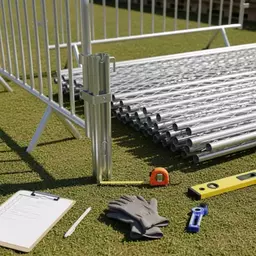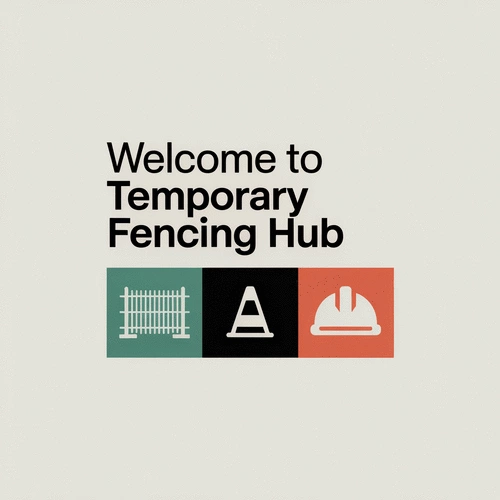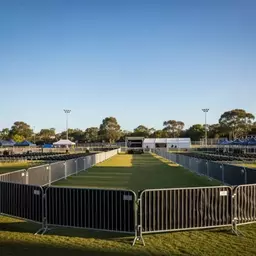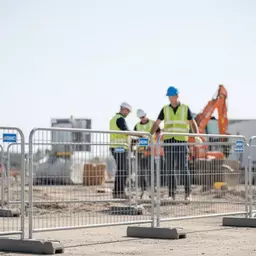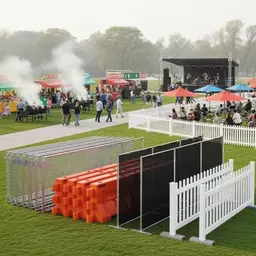As you navigate the complexities of temporary fencing, consider how the right choice can impact safety and efficiency. With so many options available, understanding your specific needs becomes paramount.
What You Will Learn
- Temporary fencing is essential for safety, crowd control, and compliance in various scenarios, from construction sites to public events.
- Key considerations for selecting fencing include project type, duration of use, local regulations, and environmental factors.
- Different types of temporary fencing serve specific needs: construction fencing offers durability, while event fencing focuses on aesthetics and ease of setup.
- Assessing value for money involves evaluating material quality, warranty support, maintenance requirements, and the cost of renting vs. purchasing options.
Types of Temporary Fencing: Construction vs. Event Needs
Understanding the distinct requirements for temporary fencing in construction versus event scenarios is crucial for safety and efficiency.
Construction Fencing
- Purpose: Secure sites, prevent unauthorized access.
- Materials: Strong, durable (chain link, steel).
- Duration: Designed for long-term use.
- Key Feature: Withstands harsh conditions.
Event Fencing
- Purpose: Crowd control, define areas, aesthetics.
- Materials: Lighter, can be decorative.
- Duration: Quick setup and takedown.
- Key Feature: Versatile for dynamic setups.
Mobile Fencing
- Benefit: Easy to move and reconfigure.
- Ideal for: Dynamic event setups and short-term needs.
- Application: Events, temporary site divisions.
- Key Feature: High adaptability.
Fixed Fencing
- Benefit: Enhanced stability and security.
- Ideal for: Longer-term projects where robustness is key.
- Application: Construction sites, permanent installations.
- Key Feature: Greater security and rigidity.
Understanding Temporary Fencing Needs in Australia
As an expert in temporary fencing solutions, I know that understanding your fencing needs is crucial for both safety and efficiency. Whether you're managing a construction site or organizing an event, the right temporary fencing can make all the difference. Let’s explore what temporary fencing is and why it's an essential consideration for Australian businesses.
Temporary fencing serves a variety of purposes, from securing construction sites to managing crowds at outdoor events. It provides safety and structure, ensuring that both workers and attendees are kept safe from hazards. In Australia, where regulations can vary by region, it’s vital to select the appropriate type of fencing that aligns with your specific project requirements. For detailed guidelines, you can refer to the AS 4687-2022 Temporary Fencing Standards Australia, which outlines the necessary specifications for temporary fences and hoardings.
What is Temporary Fencing and Why is it Important?
Temporary fencing is a type of barrier that is set up for a limited duration to protect people and property. It’s commonly used in construction zones, at festivals, and during public events. The importance of temporary fencing cannot be overstated—it not only ensures compliance with safety regulations but also helps manage crowd control effectively. Adhering to temporary fencing legal requirements in Australia is essential for all projects.
- Enhances safety for workers and the public
- Prevents unauthorized access to restricted areas
- Facilitates orderly crowd management during events
- Can be customized to fit various site requirements
By choosing the right fencing solution, businesses and event organizers can mitigate risks and enhance the overall experience for everyone involved. It's about ensuring a safe environment while also keeping your project on track!
Key Considerations for Builders and Event Organizers
When selecting temporary fencing, there are several key factors to keep in mind. First, consider the specific needs of your project. Will you need fencing that is easy to install and dismantle? Or perhaps something more robust for a high-security construction site? Understanding these requirements will guide your choices.
- Type of project: construction, event, or crowd control
- Duration of fencing use: short-term or long-term
- Local regulations and permitting requirements, such as the NSW Planning's Fences rules for exempt and complying development, which provides comprehensive information on fence regulations.
- Environmental factors, such as wind and weather conditions
These considerations will not only help you select the best fencing option but also save you time and money in the long run. Remember, when in doubt, consulting with experts can provide valuable insights tailored to your specific circumstances.
Types of Temporary Fencing: Construction vs. Event Fencing
Temporary fencing comes in various forms, particularly differentiated by its intended use. For instance, construction fencing tends to be more durable and robust, often made from materials such as chain link or steel. This type of fencing is designed to withstand harsher conditions and prevent unauthorized access to potentially dangerous areas.
- Construction Fencing: Strong, durable materials designed for long-term use
- Event Fencing: Often lighter, more aesthetic options for crowd control
- Versatile options: Can include barriers, mesh, or decorative elements depending on the event
On the other hand, event fencing is often more geared towards aesthetics and can be quickly set up and taken down. It can range from simple barriers to highly decorative options that enhance the overall look of the event. Understanding the differences can lead to better decisions for your unique needs.
Pro Tip
When selecting temporary fencing for your project, consider using modular fencing systems. These options allow for easy customization and adaptability to different site requirements. Not only do they save time during setup, but they also provide flexibility for future projects or events. Investing in modular systems can enhance safety while ensuring your fencing solutions are versatile and cost-effective.
Frequently Asked Questions About Temporary Fencing
- Q: What is the primary purpose of temporary fencing?
- A: Temporary fencing is primarily used to secure sites, prevent unauthorized access, manage crowds, and ensure safety for both workers and the public in various scenarios like construction sites and events.
- Q: What are the key differences between construction fencing and event fencing?
- A: Construction fencing is designed for durability and long-term use with strong materials like chain link or steel to withstand harsh conditions. Event fencing is lighter, often more aesthetic, and designed for quick setup and takedown for crowd control and defining areas at events.
- Q: What factors should I consider when choosing temporary fencing?
- A: Key factors include the type of project (construction, event, crowd control), duration of use, local regulations and permitting requirements, and environmental factors like wind and weather conditions.
- Q: How can I assess the value for money of temporary fencing products?
- A: To assess value, consider material quality for durability, the warranty and support offered, maintenance requirements, and whether renting or purchasing provides better financial sense for your project's duration.
- Q: When should I choose mobile fencing versus fixed fencing?
- A: Mobile fencing is ideal for dynamic setups, events, and short-term needs where easy movement and reconfiguration are necessary. Fixed fencing is best for longer-term projects requiring enhanced stability and security, such as construction sites or permanent installations.
Weighing the Options: Which Temporary Fencing Product Fits Your Needs?
Choosing the right temporary fencing product can feel daunting, especially with so many options available! That's why it's essential to weigh the benefits and costs before diving in. In this section, we'll explore how to assess value for money and long-term durability, helping you make an informed decision that fits your unique needs.
Assessing Value for Money and Long-Term Durability
When it comes to temporary fencing, understanding the balance between cost and quality is crucial. Here are key factors to consider when assessing value:
- Material Quality: Look for fences made from durable materials that can withstand the elements and frequent use.
- Warranty and Support: A good warranty indicates the manufacturer's confidence in their product, offering you peace of mind.
- Maintenance Requirements: Some products require more upkeep than others, which can impact long-term costs.
- Rental vs. Purchase Costs: Evaluate whether renting or buying makes more financial sense for your project duration.
By considering these factors, you can ensure that you're not just getting a lower price, but also a product that will last through the demands of your project or event!
Making An Informed Decision: Key Takeaways from Our Reviews
With various products on the market, it’s essential to synthesize the insights we've gathered in our reviews. Here are some critical takeaways to help guide your decision:
- Product Versatility: Some fences are better suited for construction sites, while others are ideal for public events.
- Customer Feedback: Real user reviews can provide valuable insight into performance and satisfaction.
- Compliance Features: Ensure the product meets Australian safety standards to avoid regulatory issues.
- Installation Ease: Consider how quickly and easily the fencing can be set up and taken down.
Using these key takeaways, you can narrow down your choices and select a temporary fencing solution that meets both your budget and project requirements!
Fencing Options for Different Scenarios: Mobile vs. Fixed Solutions
Understanding the specific needs of your project is vital when choosing between mobile and fixed fencing solutions. Here’s a quick breakdown:
- Mobile Fencing: Great for events and temporary situations. It’s easy to move and reconfigure as needed, making it ideal for dynamic setups.
- Fixed Fencing: Best for longer-term projects where stability is crucial. These options are often more robust and secure.
By assessing your specific scenario, you can determine which fencing type will best meet your needs, enhancing safety and efficiency on your site or during your event. Remember, the right choice can make all the difference in achieving a successful outcome!
Recap of Key Points
Here is a quick recap of the important points discussed in the article:
- Temporary fencing is essential for safety and compliance in construction and event management.
- Key considerations include project type, duration of use, local regulations, and environmental factors.
- Different types of temporary fencing, such as construction and event fencing, serve unique purposes and requirements.
- Assess value for money by considering material quality, warranty, maintenance, and rental vs. purchase costs.
- Choosing between mobile and fixed fencing solutions depends on the specific needs of your project.


